Solar Concentrator Consisting of Multiple Aspheric Reflectors
Abstract
:1. Introduction
2. Focusing Principles of a Single Aspheric Reflector
2.1. Ideas of Focusing
2.2. Analysis for Focusing Action of a Single Aspheric Reflector
2.3. Analyses for Collecting Solar Light with a Single Reflector
3. The Construction of a New Coordinate System When Vertices of Aspheric Reflectors Do Not Locate at the Origin of the Coordinate System
3.1. The Construction of a New Coordinate System and Coordinate Transformations between the Old and the New Coordinate System
3.2. Parameter Optimization of Aspheric Surfaces Whose Vertices Locate at the Origin of the New Coordinate System
4. Examples of Seeking Optimal Aspheric Parameters
4.1. Seeking Parameters of the Optimal Aspheric Surface Whose Vertex Is the XYZ Coordinate Origin
4.2. Seeking Parameters of the Optimal Aspheric Surface Whose Vertex Is at the Origin of the X′Y′Z′ Coordinate System
4.3. Computer Simulations of Focusing Effect
4.4. Verifying the Correctness of Designed Datum with Zemax Software
5. Conclusions
Author Contributions
Funding
Acknowledgments
Conflicts of Interest
References
- Shah, T.R.; Ali, H.M. Applications of hybrid nanofluids in solar energy, practical limitations and challenges: A critical review. Sol. Energy 2019, 183, 173–203. [Google Scholar] [CrossRef]
- Ahmadi, M.H.; Ghazvini, M.; Sadeghzadeh, M.; Nazari, M.A.; Ghalandari, M. Utilization of hybrid nanofluids in solar energy applications: A review. Nano-Struct. Nano-Objects 2019, 20, 100386. [Google Scholar] [CrossRef]
- Abid, M.; Ratlamwala, T.H.A.; Atikol, U. performance assessment of parabolic dish and parabolic trough solar thermal power plant using nanofluids and molten salts. Int. J. Energy Res. 2016, 40, 550–563. [Google Scholar] [CrossRef]
- Singh, G. Solar power generation by PV (photovoltaic) technology: A review. Energy 2013, 53, 1–13. [Google Scholar] [CrossRef]
- Siddiqui, R.; Kumar, R.; Jha, G.K.; Gowri, G.; Morampudi, M.; Rajput, P.; Lata, S.; Agariya, S.; Dubey, B.; Nanda, G.; et al. Comparison of different technologies for solar PV (Photovoltaic) outdoor performance using indoor accelerated aging tests for long term reliability. Energy 2016, 107, 550–561. [Google Scholar] [CrossRef]
- Wang, G.; Yao, Y.; Chen, Z.; Hu, P. Thermodynamic and optical analyses of a hybrid solar CPV/T system with high solar concentrating uniformity based on spectral beam splitting technology. Energy 2019, 166, 256–266. [Google Scholar] [CrossRef]
- Daabo, A.M.; Mahmoud, S.; Al-Dadah, R.K. The effect of receiver geometry on the optical performance of a small-scale solar cavity receiver for parabolic dish applications. Energy 2016, 114, 513–525. [Google Scholar] [CrossRef] [Green Version]
- Reddy, K.; Veershetty, G.; Vikram, T.S. Effect of wind speed and direction on convective heat losses from solar parabolic dish modified cavity receiver. Sol. Energy 2016, 131, 183–198. [Google Scholar] [CrossRef]
- Yeh, N. Illumination uniformity issue explored via two-stage solar concentrator system based on Fresnel lens and compound flat concentrator. Energy 2016, 95, 542–549. [Google Scholar] [CrossRef]
- Fernández, E.F.; Talavera, D.; Almonacid, F.M.; Smestad, G.P. Investigating the impact of weather variables on the energy yield and cost of energy of grid-connected solar concentrator systems. Energy 2016, 106, 790–801. [Google Scholar] [CrossRef]
- Rovira, A.; Barbero, R.; Montes, M.J.; Abbas, R.; Varela, F. Analysis and comparison of Integrated Solar Combined Cycles using parabolic troughs and linear Fresnel reflectors as concentrating systems. Appl. Energy 2016, 162, 990–1000. [Google Scholar] [CrossRef]
- Ng, K.M.; Adam, N.M.; Azmi, B.Z.; Wahab, M.A.; Sulaiman, M.Y. Field study of solar bowl under Malaysian tropical climate. WSEAS Trans. Environ. Dev. 2012, 8, 48–59. [Google Scholar]
- Stine, W.B. Power from the Sun: Principles of High Temperature Solar Thermal Technology; Solar Energy Research Institute: Golden, CO, USA, 1987. [Google Scholar]
- Qin, H.; Lei, C.; Liu, H.; Wang, Y.; Yuan, W. Optical design of an aspherical cylinder-type reflecting solar concentrator. Energy 2013, 57, 751–758. [Google Scholar] [CrossRef]
- Li, Q.; Shirazi, A.; Zheng, C.; Rosengarten, G.; Scott, J.A.; Taylor, R.A. Energy concentration limits in solar thermal heating applications. Energy 2016, 96, 253–267. [Google Scholar] [CrossRef]
- Burgess, G.; Lovegrove, K.; Mackie, S.; Zapata, J.; Pye, J. Direct steam generation using the SG4 500 m2 paraboloidal dish concentrator. In Proceedings of the 17th SolarPACES Conference, Granada, Spain, 20–23 September 2011. [Google Scholar]
- Rodriguez-Sanchez, D.; Rosengarten, G. Improving the concentration ratio of parabolic troughs using a second-stage flat mirror. Appl. Energy 2015, 159, 620–632. [Google Scholar] [CrossRef]
- Balaji, S.; Reddy, K.S.; Sundararajan, T. Optical modeling and performance analysis of a solar LFR receiver system with parabolic and involute secondary reflectors. Appl. Energy 2016, 179, 1138–1151. [Google Scholar] [CrossRef]
- Benyakhlef, S.; Al Mers, A.; Merroun, O.; Bouatem, A.; Boutammachte, N.; El Alj, S.; Ajdad, H.; Erregueragui, Z.; Zemmouri, E.; Ossama, M. Impact of heliostat curvature on optical performance of Linear Fresnel solar concentrators. Renew. Energy 2016, 89, 463–474. [Google Scholar] [CrossRef]
- Sharma, V.; Nayak, J.K.; Kedare, S.B. Comparision of line focusing solar concentrator fields considering shading and blocking. Sol. Energy 2015, 122, 924–939. [Google Scholar] [CrossRef]
- Onubogu, N.O.; Chong, K.-K.; Wong, C.-W.; Yew, T.-K.; Lim, B.-H. Optical characterization of two-stage non-imaging solar concentrator for active daylighting system. Sol. Energy 2019, 185, 24–33. [Google Scholar] [CrossRef]
- Xiao, J.; Wei, X.; Gilaber, R.N.; Zhang, Y.; Li, Z. Design and characterization of a high-flux non-coaxial concentrating solar simulator. Appl. Therm. Eng. 2018, 145, 201–211. [Google Scholar] [CrossRef]
- Barbon, A.; Barbón, N.; Bayón, L.; Otero, J. Theoretical elements for the design of a small scale Linear Fresnel Reflector: Frontal and lateral views. Sol. Energy 2016, 132, 188–202. [Google Scholar] [CrossRef]
- Boito, P.; Grena, R. Optimizaition of the geometry of Fresnel linear collectors. Sol. Energy 2016, 135, 479–486. [Google Scholar] [CrossRef]
- Zhu, Y.; Shi, J.; Li, Y.; Wang, L.; Huang, Q.; Xu, G. Design and experimental investigation of a stretched parabolic linear Fresnel reflector collecting system. Energy Convers. Manag. 2016, 126, 89–98. [Google Scholar] [CrossRef]
- N’Tsoukpoe, K.E.; Azoumah, K.Y.; Ramde, E.; Fiagbe, A.Y.; Neveu, P.; Py, X.; Gaye, M.; Jourdan, A. Integrated design and construction of a micro-central tower power plant. Energy Sustain. Dev. 2016, 31, 1–13. [Google Scholar] [CrossRef]
- Loni, R.; Kasaeian, A.; Asli-Ardeh, E.A.; Ghobadian, B. Optimizing the efficiency of a solar receiver with tubular cylindrical cavity for a solar-powered organic Rankine cycle. Energy 2016, 112, 1259–1272. [Google Scholar] [CrossRef]
- Liang, C.-W.; Lin, J.-S. High concentration thin profile solar concentrator utilizing toroidal confocal relay. Sol. Energy 2015, 122, 264–270. [Google Scholar] [CrossRef]
- Dähler, F.; Ambrosetti, G.; Montoya-Zegarra, J.A.; Schindler, K.; Steinfeld, A. High-concentration solar dishes based on pneumatic reflecting membranes. Sol. Energy 2016, 124, 89–100. [Google Scholar] [CrossRef]
- Canavarro, D.; Chaves, J.; Collares-Pereira, M. A novel Compound Elliptical-type Concentrator for parabolic primaries with tubular receiver. Sol. Energy 2016, 134, 383–391. [Google Scholar] [CrossRef]
- Tsai, C.-Y. Improved irradiance distribution on high concentration solar cell using free-form concentrator. Sol. Energy 2015, 115, 694–707. [Google Scholar] [CrossRef]
- Tsai, C.-Y. Optimized solar thermal concentrator system based on free-form trough reflector. Sol. Energy 2016, 125, 146–160. [Google Scholar] [CrossRef]
- Perez-Enciso, R.; Gallo, A.; Riveros-Rosas, D.; Fuentealba-Vidal, E.; Perez-Rábago, C. A simple method to achieve a uniform flux distribution in a multi-faceted point focus concentrator. Renew. Energy 2016, 93, 115–124. [Google Scholar] [CrossRef]
- Meng, X.-L.; Xia, X.-L.; Sun, C.; Li, Y.; Li, X.-L. A novel free-form Cassegrain concentrator for PV/T combining utilization. Sol. Energy 2016, 135, 864–873. [Google Scholar] [CrossRef]
- Shanks, K.; Ferrer-Rodriguez, J.P.; Fernández, E.F.; Almonacid, F.; Pérez-Higueras, P.; Senthilarasu, S.; Mallick, T. A >3000 suns high concentrator photovoltaic design based on multiple Fresnel lens primaries focusing to one central solar cell. Sol. Energy 2018, 169, 457–467. [Google Scholar] [CrossRef]
- Wang, G.; Wang, F.; Shen, F.; Jiang, T.; Chen, Z.; Hu, P. Experimental and optical performances of a solar CPV device using a linear Fresnel reflector concentrator. Renew. Energy 2020, 146, 2351–2361. [Google Scholar] [CrossRef]
- Zheng, H.; Feng, C.; Su, Y.; Dai, J.; Ma, X. Design and experimental analysis of a cylindrical compound Fresnel solar concentrator. Sol. Energy 2014, 107, 26–37. [Google Scholar] [CrossRef]
- Sahin, F.E.; Yılmaz, M. High Concentration Photovoltaics (HCPV) with Diffractive Secondary Optical Elements. Photonics 2019, 6, 68. [Google Scholar] [CrossRef]
- Qin, H.; Pang, X. Novel method to design laser beam shaping lenses using PSO techniques. Appl. Phys. B 2019, 125, 7. [Google Scholar] [CrossRef]
- Pang, X.; Qin, H. Method for employing particle swarm algorithm to design LED collimator system. J. Optoelectron. Adv. Mater. 2019, 21, 35–47. [Google Scholar]
- Qin, H. Aberration correction of a single aspheric lens with particle swarm algorithm. Opt. Commun. 2012, 285, 2996–3000. [Google Scholar] [CrossRef]
- García-Botella, A.; Jiang, L.; Winston, R. Flowline Optical Simulation to Refractive/Reflective 3D Systems: Optical Path Length Correction. Photonics 2019, 6, 101. [Google Scholar] [CrossRef]
- Sahin, F.E. Open-source optimization algorithms for optical design. Optik 2019, 178, 1016–1022. [Google Scholar] [CrossRef]
- Houllier, T.; Lépine, T. Comparing optimization algorithms for conventional and freeform optical design: Erratum. Opt. Express 2019, 27, 28383. [Google Scholar] [CrossRef]
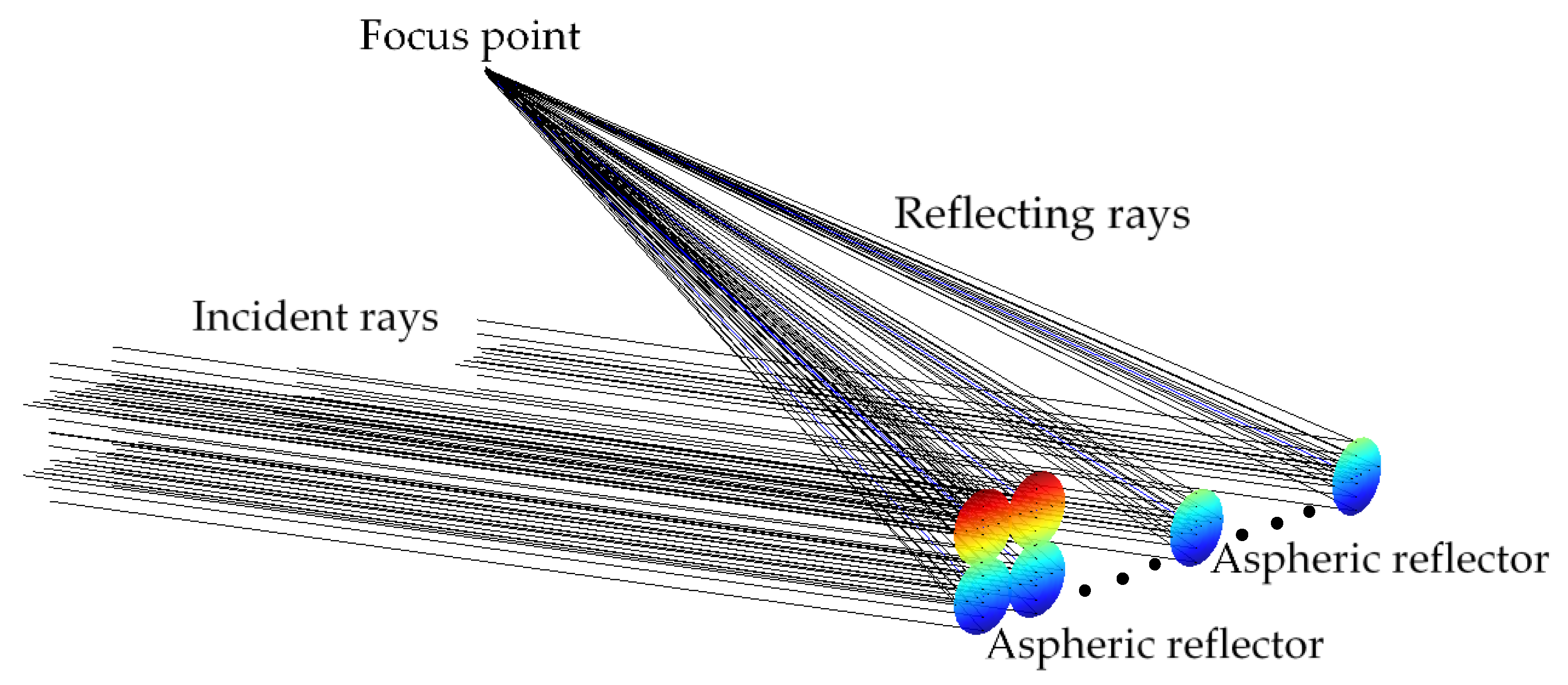
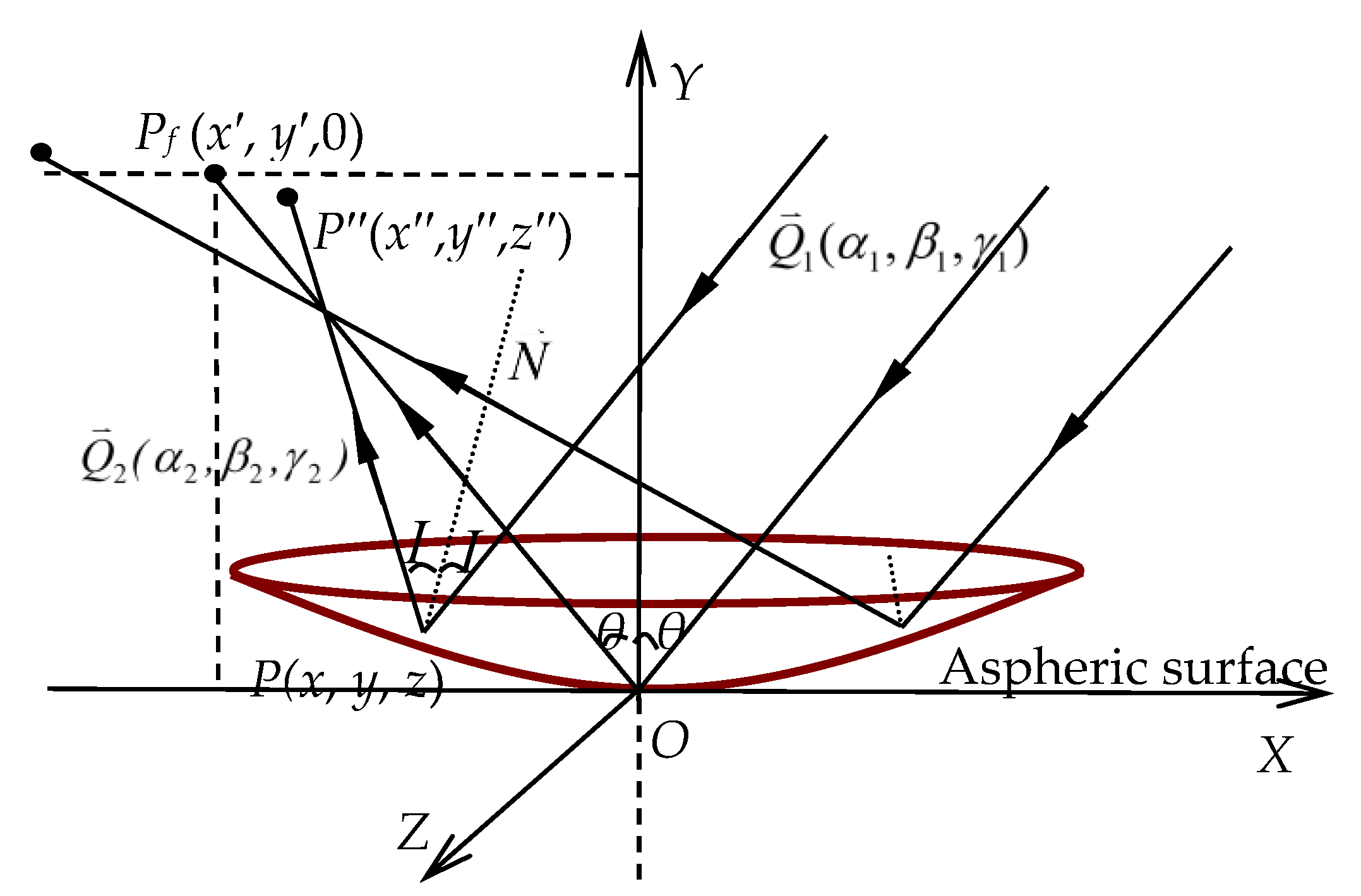
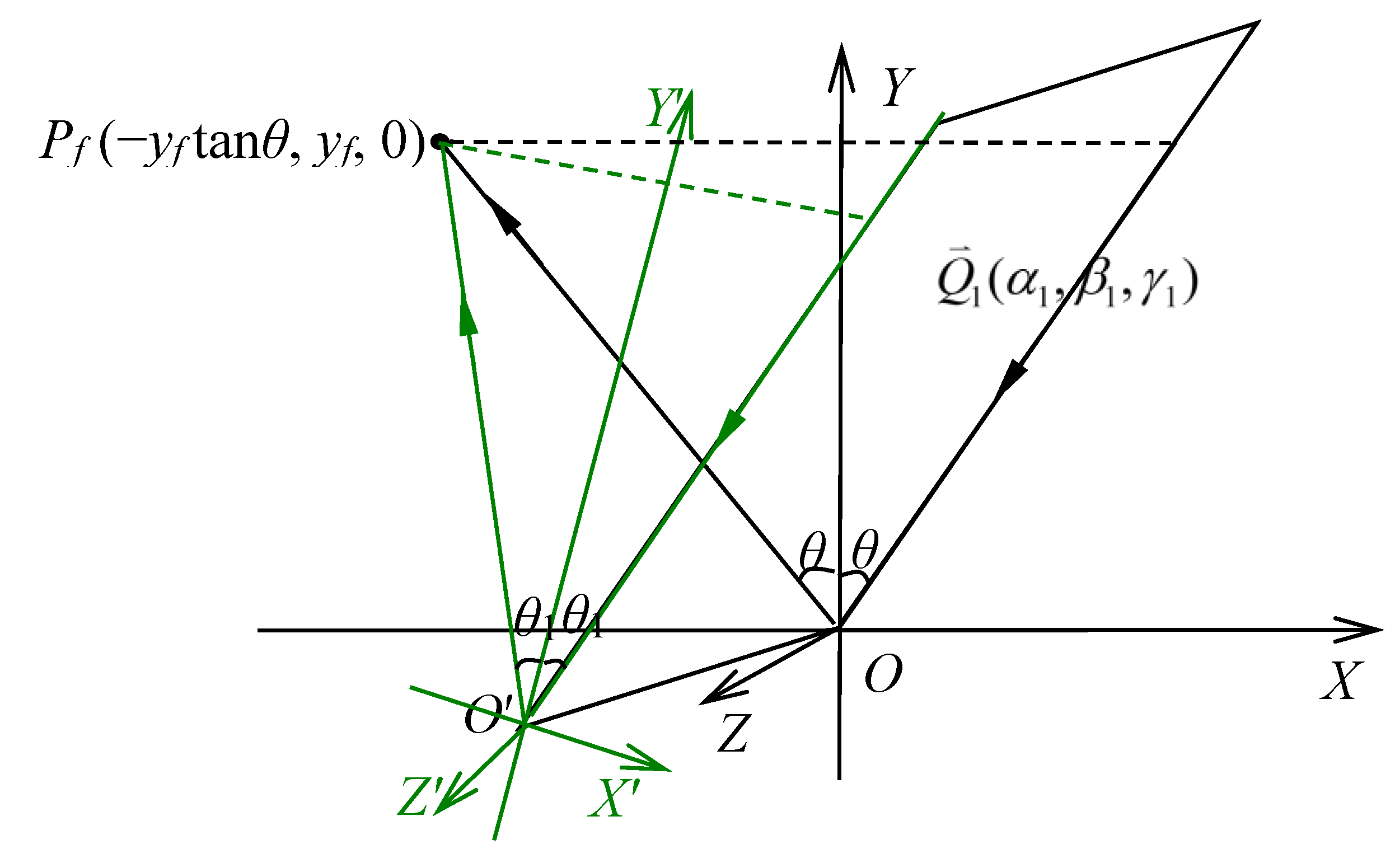

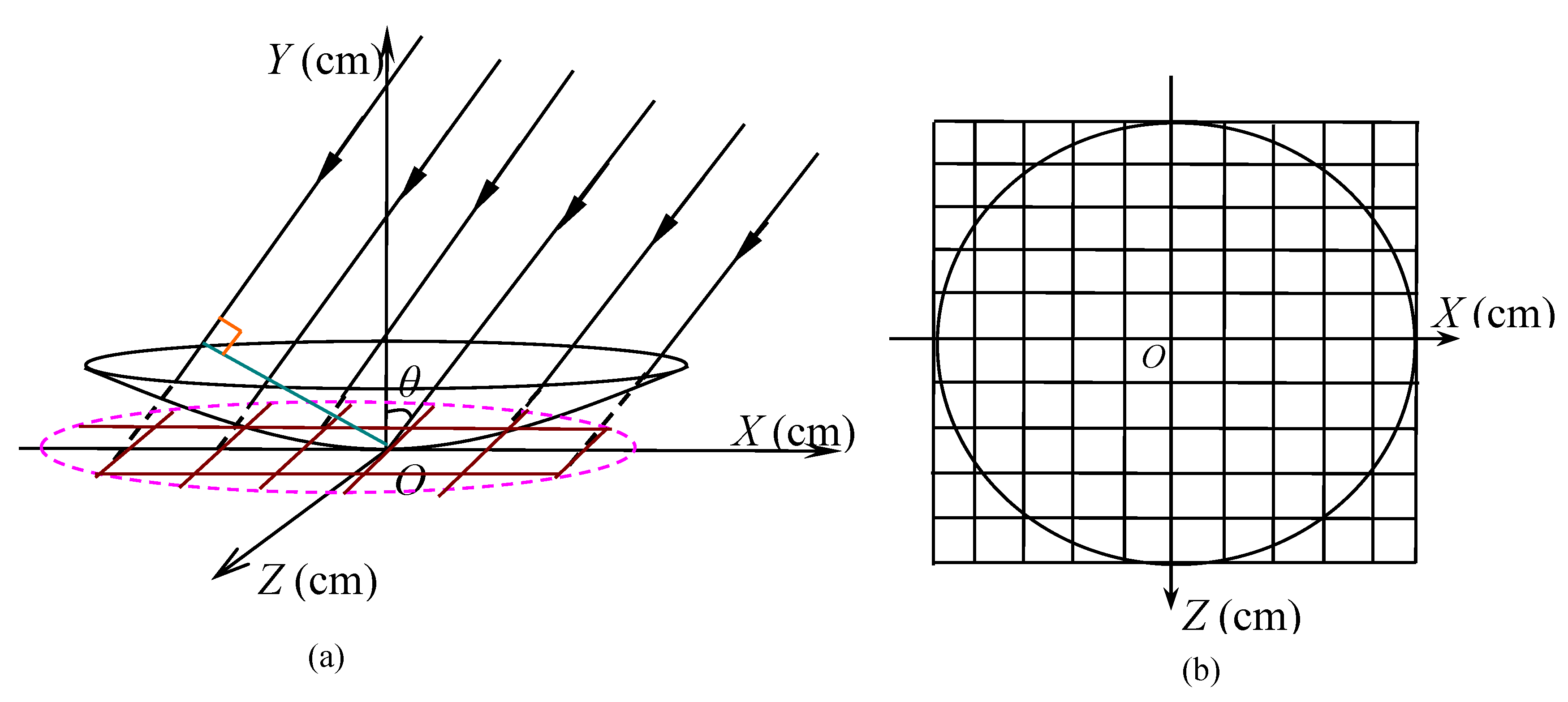
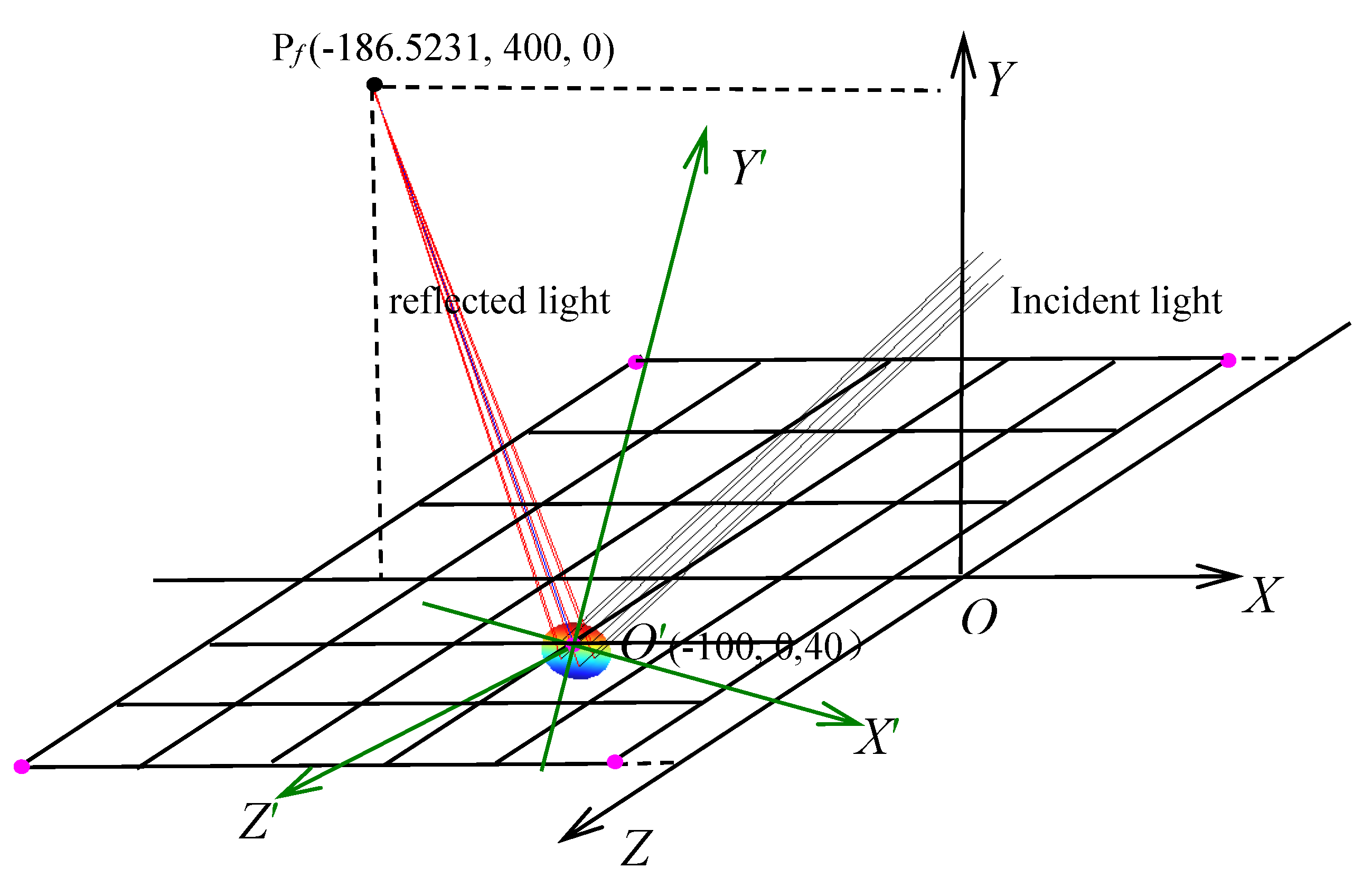
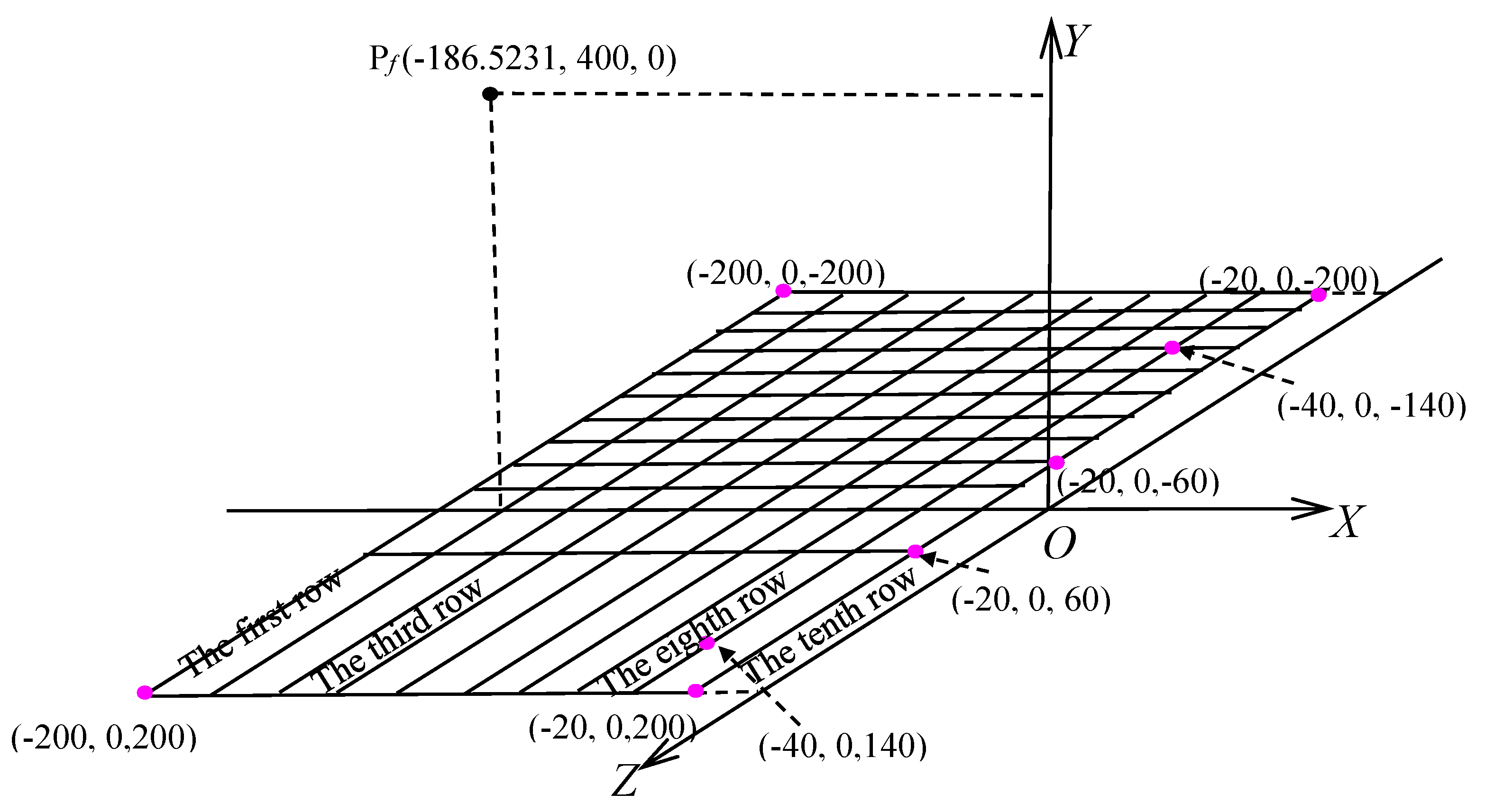
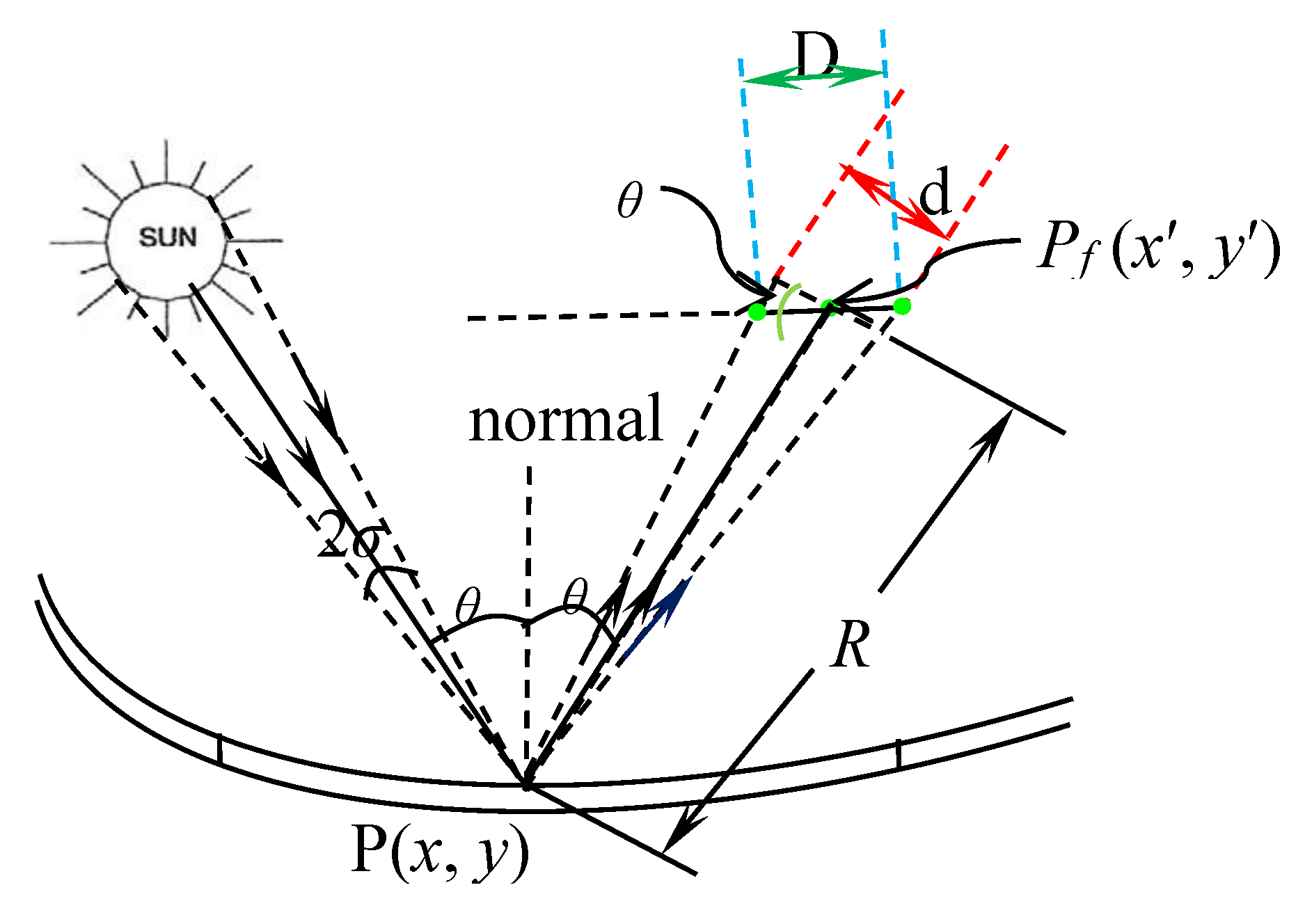
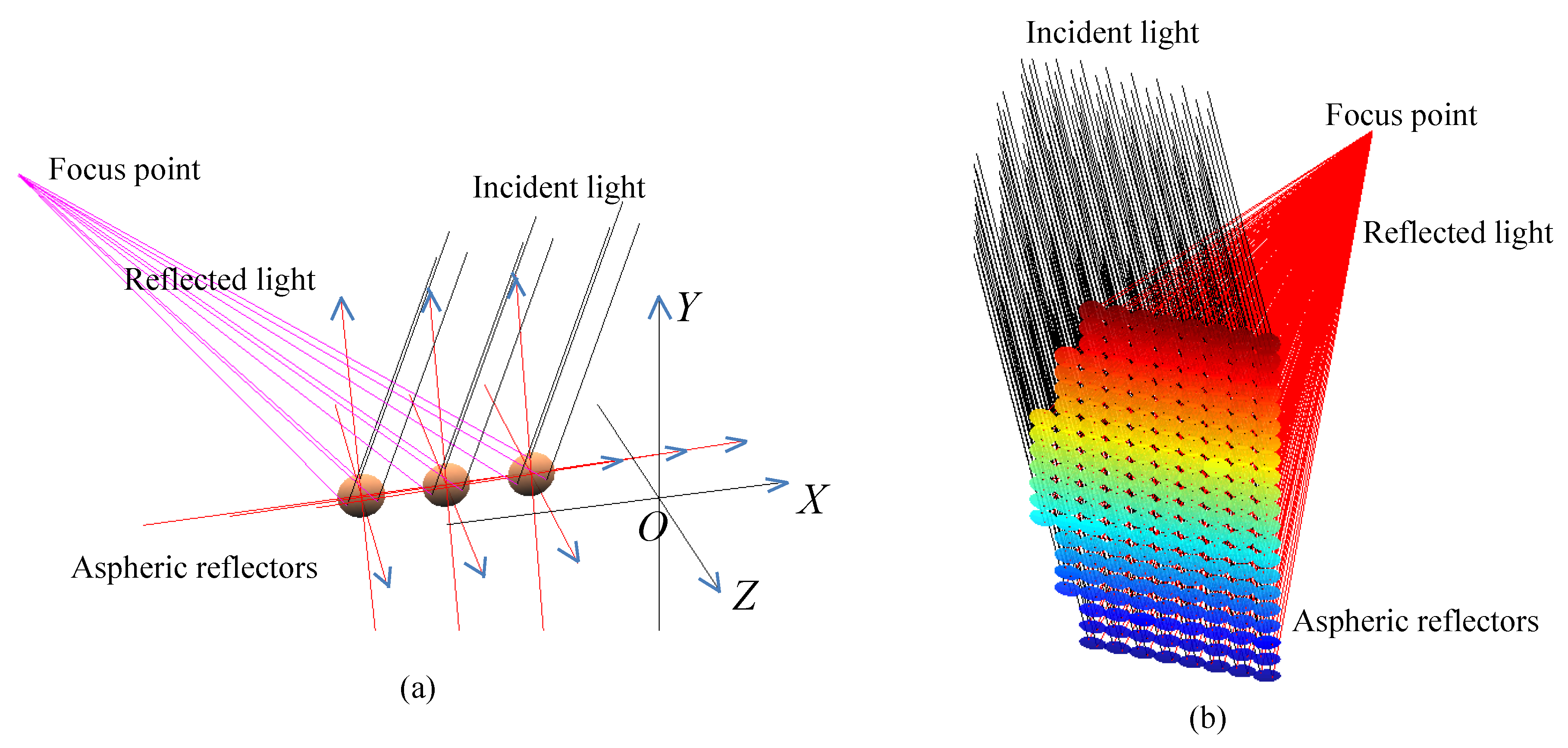
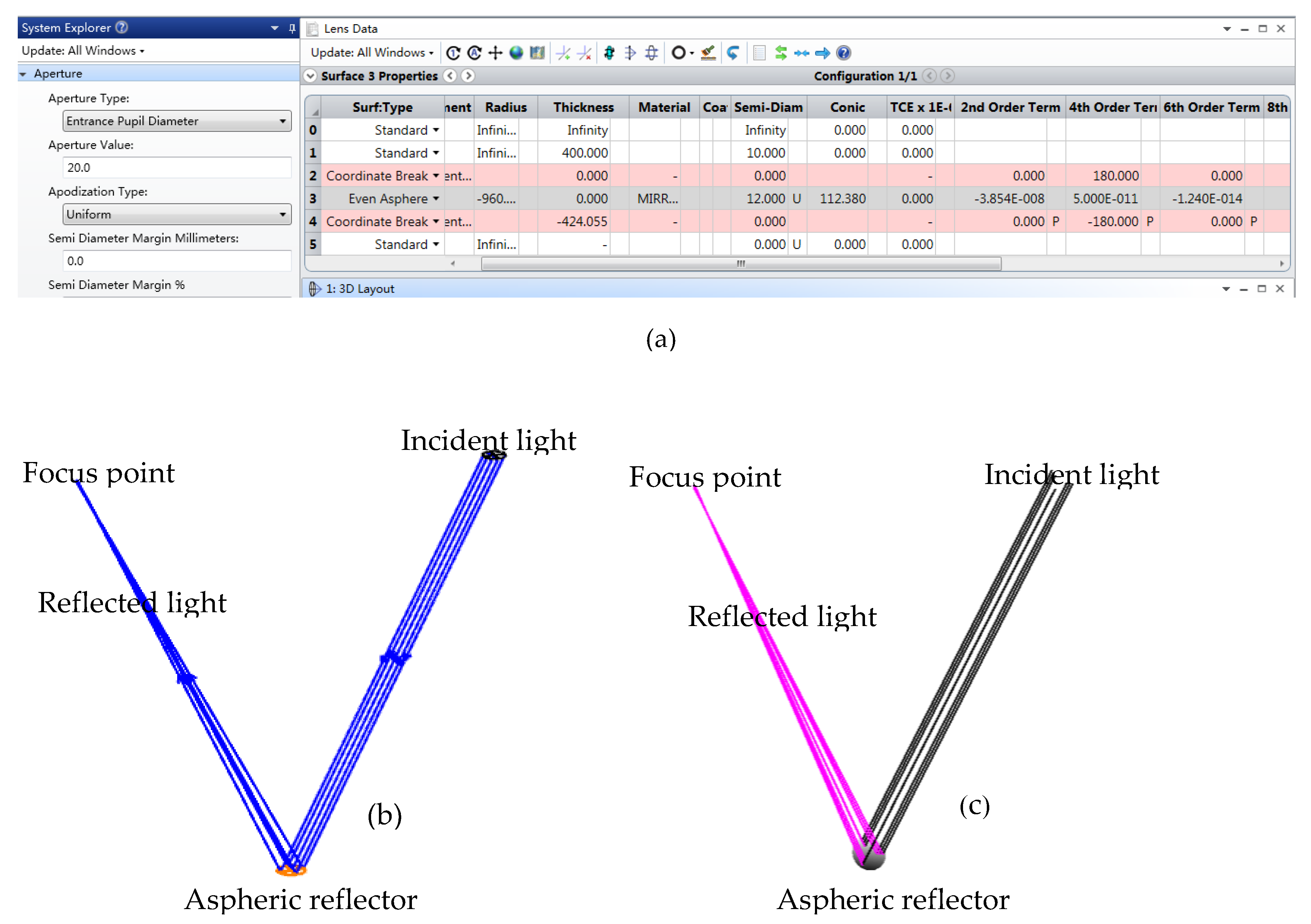
| Aspheric Vertex Coordinates (cm) | r = 1/C (cm) | a2 | a4 | a6 | a8 | Max (Ri) |
|---|---|---|---|---|---|---|
| (−60, 0,200) | −960.0 | 112.3796 | −3.8535 × 10−8 | 5.0000 × 10−11 | −1.2403 × 10−14 | 1.0000 |
| (−60, 0,180) | −932.9969 | 88.3578 | −1.0400 × 10−8 | 3.7394 × 10−11 | −5.0000 × 10−14 | 0.9735 |
| (−60, 0,160) | −915.8788 | 33.9926 | −1.8546 × 10−8 | 3.7024 × 10−11 | −2.2159 × 10−14 | 0.9285 |
| (−60, 0,140) | −900.6793 | 24.1044 | −7.0350 × 10−9 | −5.0000 × 10−11 | −5.0000 × 10−14 | 0.8844 |
| (−60, 0,120) | −887.8191 | 45.6911 | −4.0313 × 10−10 | −5.0000 × 10−11 | −3.0517 × 10−14 | 0.8611 |
| (−60, 0,100) | −876.9833 | 52.5050 | −1.6645 × 10−8 | 5.0000 × 10−11 | −5.0000 × 10−14 | 0.8238 |
| (−60, 0,80) | −866.0193 | 50.0 | 3.8941 × 10−9 | −5.0000 × 10−11 | −5.0000 × 10−15 | 0.7979 |
| (−60, 0,60) | −861.4021 | 21.1483 | −2.8481 × 10−8 | 4.7987 × 10−11 | 2.8180 × 10−14 | 0.7717 |
| (−60, 0,40) | −860.0 | 60.0000 | −2.7203 × 10−8 | −3.6588 × 10−12 | −8.0359 × 10−15 | 0.7508 |
| (−60, 0,20) | −851.1841 | 50.0000 | −5.5993 × 10−9 | −1.3237 × 10−12 | 3.3003 × 10−14 | 0.7577 |
| (−60, 0,0) | −850.1531 | 39.1247 | −4.6066 × 10−9 | −2.4065 × 10−11 | −1.7072 × 10−15 | 0.7520 |
| (−60, 0, −20) | −860.0 | 108.9231 | −4.0558 × 10−8 | 4.8699 × 10−11 | 4.5294 × 10−14 | 0.7309 |
| (−60, 0, −40) | −856.2597 | 53.8495 | −1.7924 × 10−8 | 1.6465 × 10−11 | 3.3017 × 10−14 | 0.7555 |
| (−60, 0, −60) | −860.6008 | 138.2402 | 7.7073 × 10−9 | −2.0915 × 10−12 | −4.4140 × 10−15 | 0.7779 |
| (−60, 0, −80) | −868.1085 | 0.8521 | −1.8913 × 10−8 | −2.0171 × 10−11 | −1.3113 × 10−14 | 0.7943 |
| (−60, 0, −100) | −876.6630 | 3.9000 | −1.9007 × 10−8 | 1.6750 × 10−11 | −3.8802 × 10−14 | 0.8267 |
| (−60, 0, −120) | −888.1854 | 37.8347 | −1.3108 × 10−8 | 2.0836 × 10−12 | −1.4232 × 10−15 | 0.8555 |
| (−60, 0, −140) | −890.3378 | −94.1528 | 1.6813 × 10−8 | 5.6164 × 10−12 | −5.0000 × 10−14 | 0.9515 |
| (−60, 0, −160) | −915.5987 | −18.1712 | −2.0586 × 10−8 | −2.6041 × 10−12 | 1.3613 × 10−14 | 0.9298 |
| (−60, 0, −180) | −933.2251 | −39.6372 | −2.2386 × 10−8 | −2.6279 × 10−11 | 2.5424 × 10−14 | 0.9749 |
| (−60, 0, −200) | −951.6965 | −14.6271 | −1.4399 × 10−8 | −5.0000 × 10−11 | −2.2127 × 10−14 | 1.0000 |
© 2019 by the authors. Licensee MDPI, Basel, Switzerland. This article is an open access article distributed under the terms and conditions of the Creative Commons Attribution (CC BY) license (http://creativecommons.org/licenses/by/4.0/).
Share and Cite
Cao, G.; Qin, H.; Ramachandran, R.; Liu, B. Solar Concentrator Consisting of Multiple Aspheric Reflectors. Energies 2019, 12, 4038. https://doi.org/10.3390/en12214038
Cao G, Qin H, Ramachandran R, Liu B. Solar Concentrator Consisting of Multiple Aspheric Reflectors. Energies. 2019; 12(21):4038. https://doi.org/10.3390/en12214038
Chicago/Turabian StyleCao, Guobin, Hua Qin, Rajan Ramachandran, and Bo Liu. 2019. "Solar Concentrator Consisting of Multiple Aspheric Reflectors" Energies 12, no. 21: 4038. https://doi.org/10.3390/en12214038
APA StyleCao, G., Qin, H., Ramachandran, R., & Liu, B. (2019). Solar Concentrator Consisting of Multiple Aspheric Reflectors. Energies, 12(21), 4038. https://doi.org/10.3390/en12214038






